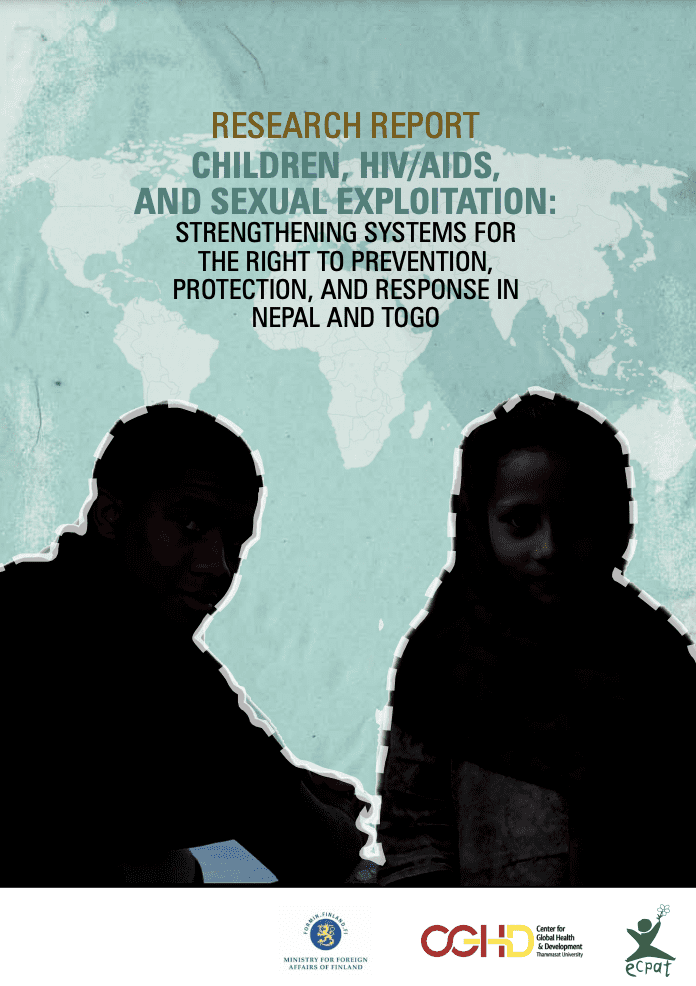
Children, HIV/AIDS, and Sexual Exploitation
Children who are vulnerable to commercial sexual exploitation are also vulnerable to infection with HIV. However, because they often live on the margins of society and outside of the health system, they are rarely identified as at risk of HIV nor are they measured for HIV infection. As such, they neither appear in the numerator nor in the denominator of national HIV statistics. As a result, they may be infected without knowing their HIV status, and will only access the health system when they have developed an opportunistic infection related to AIDS. In addition, because of a lack of information on their status, programs directed at HIV/ AIDS may not include children vulnerable to commercial exploitation in the key populations at risk of HIV (i.e., female sex Workers, men who have sex with men, intravenous drug users, or people receiving blood transfusions). In some cases, child protection agencies that work with children in or at risk of commercial sexual exploitation may not include HIV or AIDS prevention programs in their interventions.
In order to measure the extent of HIV infection in this group of vulnerable children and to understand how their infections could have been identified earlier, and how they could be better educated about the dangers of HIV, a study was done of HIV prevalence in 308 randomly selected vulnerable children in Kathmandu. The children were also interviewed to garner an understanding for their attitudes, knowledge and behavior related to living and work conditions, schooling, and sexual behavior in a joint project by ECPAT International and the Center for Global Health and Development of Thammasat University. An additional 151 children were also interviewed using the same survey instrument in two cities in Togo, Lomé and Atakpamé, in order to correlate responses that might predict vulnerability to HIV infection in those surroundings. The study built on the strengths of the Youth Partnership Programs that operate in both Nepal and Kathmandu through the auspices of two NGOs: Maiti Nepal and WAO Afrique.
Children between the ages of 15 and 25 years old were included in the sampling frame if they fulfilled two of six inclusion criteria that defined vulnerability (i.e., having lost one or both parents, one or both parents infected with HIV, recently dropped out of school, living on the street for more than two weeks, living away from home for more than two weeks, working on the street during school hours or at night, known to be involved in CSEC, working in the entertainment industry, or domestic workers). After receiving informed consent and assent, their HIV status was tested anonymously using a rapid, oral noninvasive HIV antibody test (OraQuick®).
Prevalence levels of HIV infection were high. In the entire sample, 11 children tested positive for HIV; for children < 18 years the prevalence was 3.7%. For girls who reported being sexually active, the prevalence was 9.4%. These prevalence figures are higher than those of female sex workers (2.2%) in Kathmandu and the clients of sex workers (2%), and compare with those of men who have sex with men (3.8%). Of concern is that only four out of the 11 who tested positive for HIV infection had been previously tested for HIV – the others have remained outside of the system, concealing a hidden epidemic unknown to the government or to the health care delivery system.
The results of the survey linked these infected children to major risk factors: coming from a poor family, having lost one or more parents, and early debut of sexual activity (≤15 years). Infection was through sexual transmission; there were no intravenous drug users or blood transfusions in the infected group. The same risk factors were found, often to a greater degree, in the Togo sample, suggesting that should those children be tested (the Government of Togo denied permission to use the rapid oral test), they would be found to have the same if not higher prevalence as those children in Nepal.
This report includes a number of recommendations, the most important of which is that every effort should be made to get these children tested through improved access to free counseling and testing services. This is the only way that AIDS can be prevented. In Nepal, there was no resistance to the use of the rapid oral test, and its advantages (i.e., no discomfort from injection, no possibility of blood contamination or contagion, easy and safe disposal of used kits, etc.) made it particularly suitable for testing in the neighborhoods or environments where these children live. It is also imperative to use this contact for the prevention of HIV infection as well, by educating children about safe sex, and by identifying a concerned adult or young person who can be a mentor or support to these otherwise marginalized and often isolated children. There is every indication that the children in Lomé and Atakpamé are at risk and efforts should be increased to reach these children with safe and confidential testing and education.
Finally, it is hoped that the significance of the high prevalence of HIV infection in this group of vulnerable children will provide the evidence needed to consider them as a key population at higher risk of HIV similar to FSWs, MSMs, and IDUs. They should be included as a priority group in local and national HIV/AIDS programs as well as programs for prevention of commercial sexual exploitation of children.
Read more here.
